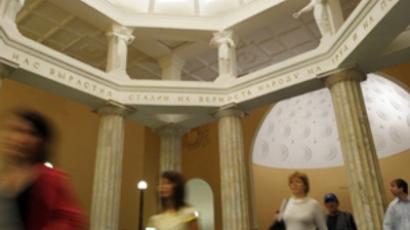Moscow's Metro: 75 years of beauty in motion
Opened on May 15, 1935, the Moscow Metro was intended to display the best of Soviet architecture. 75 years later, the Metro is renowned for being one of the biggest and most beautiful in the world.
Stations of the Moscow Metro, famed worldwide for their elegant designs and the lavish use of marble, mosaics chandeliers and sculptures, seem more like grand museums rather than functioning train stations. Each station is uniquely planned, with its own theme and embellishments.
“For the last 75 years the metro has been developing, and the trademark has been the architecture. That’s what sets it apart from the metro systems in other countries,” said designer Nikolay Shumakov.
The Metro is a place with its own traditions. Among all the grandeur and glamour a favorite spot with visitors and Muscovites alike is a small bronze dog in one of the central stations. His snout is rubbed golden by people who touch it, believing it will bring them luck.
Original plans for the Metro were drawn up in 1902, but World War I and the Revolution meant construction didn’t get underway until the 1930s.
The first line of the extravagantly designed Metro was the Red Line, with just 13 stations.
The opening of the underground was a cause for huge celebration and pride among Muscovites.
“Everyone called it 'our palace,' and that really was what it was like,” said local resident Galina Gorelova.
The anniversary is a chance to celebrate the success of the Metro system and the incredible efforts of those who helped create it all those years ago.
“I began working on the Metro construction as a tunneler in 1934,” said Grigoriy Fish. “It was hard work, but our enthusiasm was high. We were given tools, a 24 hour canteen and a medical centrer, so all the conditions were created for good but solid work.”
Work continued throughout World War II, when the stations were used as air raid shelters.
“This is the area where we slept during the war,” recalled Gorelova. “I was 11 at the time. There were wooden bunk beds here and we slept with our clothes on because it was very cold. Every morning we’d be woken at 5 am and go home. Whenever I go through this corridor, I cry remembering the war.”
Today the Metro system has grown into a network of 12 lines and 180 stations, with new ones opening every year.
Around 3 billion people a year use the Moscow Metro. For many, it provides the cheapest and most effective form of transport.
With over 9 million people using it every day, it can sometimes be a bit of a squeeze.
“Everybody knows how crowded the Metro gets during rush hours,” said Shumakov. “Today we have 300 kilometers of Metro line, we need twice as much to relieve the situation. We are currently finishing two new stations, which will be opening soon.”













